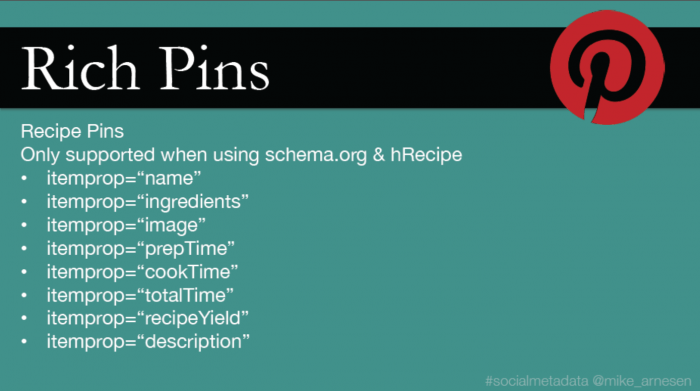This post is the second in a series that looks at social media meta tags and the ways they can power up your social content. In Part 1 we looked at tags that work with Facebook and Twitter (OpenGraph and Twitter Cards); in this post, we’ll examine the tags for Pinterest and Google+.
As a refresher: meta tags are strings of code that help to explain in specific terms the content a web page features. A well-chosen meta tag can give a page an image, a description, potentially even a call to action, when the page is shared as a link – information that search engines index, and that businesses in turn can harness to drive traffic to their sites.
Rich Pins on Pinterest
Rich pins help flesh out a brand’s offerings on Pinterest, allowing links to product pages (and price points) to be embedded in pins directly (versus in a separate pop-up window). There are currently five types of rich pins: movie, recipe, article, product, and place, and companies of all sizes have already taken to them in droves (Anthropologie, Home Depot, Sephora to name a few).
Rich pins mark an important evolution in the Pinterest platform, and may well be a tremendous asset for your business. Sephora found that its Pinterest visitors spend 15 times more than its Facebook followers; Shopify notes that referrals from Pinterest place an average sales order of $80, relative to just $40 via Facebook. In the rich pin below, the green arrow notes the result of the pricing meta tag (and pinners can get notifications when product Pins they’ve added drop in price), while the product meta tag enables the direct link to the seller (red arrow).
If you’re looking to put these pins to use, you’ll want to pay Pinterest’s developers page a visit, as it clarifies the exact semantic markup to input on your site’s backend and offers a walkthrough of the implementation process. Once you’ve incorporated the correct code on your page, you’ll need to validate your pins here.
Mike Arnesen, a senior SEO analyst for Swellpath, has a presentation on SlideShare in which he gives an overview of various social media meta tag codes; here’s what the Pinterest slide looks like. You’ll note that Pinterest uses the Open Graph protocol:
 Here’s what the meta tag options are for a recipe card:
Here’s what the meta tag options are for a recipe card:
…and here’s what the results look like:
Interactive Posts on Google+
Google Plus can use meta tags in Articles, Blog, Book, Event, Local Business, Organization, Person, Product, and Reviews categories. You can also create an “interactive” post that lets you enhance your existing sharing by embedding a clickable Call to Action in your post. You could, for example, share a blog post about an event you’re hosting, and link right to the registration form. You can’t create your own CTA label; Google limits the selection so it can manage the coding and translate that CTA into the native language of every Google+ user who views it. But that’s not much of a hindrance, as it’s a pretty wide selection – and you don’t have to worry about how a button will render.
 (Image from Moz.com)
(Image from Moz.com)
Posts of this sort boost engagement, making the experience more personal for the visitor; they also better integrate branded social pages with external outreach efforts, and engage mobile users. The inclusion of CTAs serves to drive clickthroughs (3x more than usual) and monetize a business’ offerings on G+.
According to the platform’s official blog for developers, a number of companies have already seized on this opportunity. Fancy, for one, uses interactive posts to let users create a group gift to which their followers can contribute. The end result is a highly targeted, action-oriented piece of content which helps build brand awareness and traffic for Fancy while pleasing users – proof that the right interactive post can do wonders for a business’ strategic shares on G+.
If you’re hoping to take advantage of these posts yourself, you’ll want to visit the official G+ page for developers, which specifies the code you’ll need to include on your site’s backend and breaks down the implementation process. Bernadette Coleman also has this helpful walkthrough to offer on Moz’s official blog. And, read Mike’s post on SwellPath to check out the Interactive Posts Command Center they offer; it will help you create and push out Google+ Interactive posts.
When all is done and said, it’s important to remember that a brand’s success on social depends largely on the attention it pays to its social displays – to whether the content it shares is truly appealing and engaging. To this end, social media meta tags could function as an integral way of tying your pages on social to your overall online presence.
For other ways to improve your social pages and enrich your efforts at outreach, make sure to check out our Center of Excellence.




